Solar eclipse of April 20, 2023
| Solar eclipse of April 20, 2023 | |
|---|---|
 Map | |
| Type of eclipse | |
| Nature | Hybrid |
| Gamma | -0.3952 |
| Magnitude | 1.0132 |
| Maximum eclipse | |
| Duration | 76 sec (1 m 16 s) |
| Coordinates | 9°36′S 125°48′E / 9.6°S 125.8°E |
| Max. width of band | 49 km (30 mi) |
| Times (UTC) | |
| Greatest eclipse | 4:17:56 |
| References | |
| Saros | 129 (52 of 80) |
| Catalog # (SE5000) | 9559 |
A total solar eclipse will occur on April 20, 2023. A solar eclipse occurs when the Moon passes between Earth and the Sun, thereby totally or partly obscuring the image of the Sun for a viewer on Earth. A total solar eclipse occurs when the Moon's apparent diameter is larger than the Sun's, blocking all direct sunlight, turning day into darkness. Totality occurs in a narrow path across Earth's surface, with the partial solar eclipse visible over a surrounding region thousands of kilometres wide.
It is a hybrid eclipse, with portions of its path near sunrise and sunset as annular.
Images

Animated path
Related eclipses
Solar eclipses of 2022-2025
Each member in a semester series of solar eclipses repeats approximately every 177 days and 4 hours (a semester) at alternating nodes of the Moon's orbit.
| Solar eclipse series sets from 2022-2025 | |||||
|---|---|---|---|---|---|
| Ascending node | Descending node | ||||
| 119 | April 30, 2022 Partial |
124 | October 25, 2022 Partial | ||
| 129 | April 20, 2023 Hybrid |
134 | October 14, 2023 Annular | ||
| 139 | April 8, 2024 Total |
144 | October 2, 2024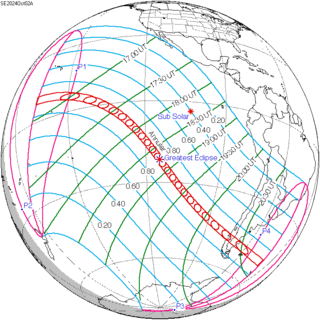 Annular | ||
| 149 | March 29, 2025 Partial |
154 | September 21, 2025 Partial | ||
Saros 129
It is a part of Saros cycle 129, repeating every 18 years, 11 days, containing 80 events. The series started with partial solar eclipse on October 3, 1103. It contains annular eclipses on May 6, 1464 through March 18, 1969, hybrid eclipses on April 8, 2005 and April 20, 2023 and total eclipses from April 30, 2041 through July 26, 2185. The series ends at member 80 as a partial eclipse on February 21, 2528. The longest duration of totality was 3 minutes, 43 seconds on June 25, 2131 .[1]
| Series members 46-56 occur between 1901 and 2100: | ||
|---|---|---|
| 46 | 47 | 48 |
 February 14, 1915 |
 February 24, 1933 |
 March 7, 1951 |
| 49 | 50 | 51 |
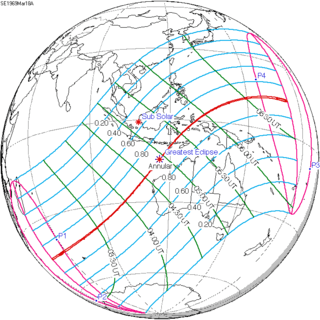 March 18, 1969 |
 March 29, 1987 |
 April 8, 2005 |
| 52 | 53 | 54 |
 April 20, 2023 |
 April 30, 2041 |
 May 11, 2059 |
| 55 | 56 | |
 May 22, 2077 |
 June 2, 2095 | |
Metonic series
The metonic series repeats eclipses every 19 years (6939.69 days), lasting about 5 cycles. Eclipses occur in nearly the same calendar date. In addition the octon subseries repeats 1/5 of that or every 3.8 years (1387.94 days).
| 21 eclipse events, progressing from north to south between July 1, 2000 and July 1, 2076 | ||||
|---|---|---|---|---|
| July 1-2 | April 19-20 | February 5-7 | November 24-25 | September 12-13 |
| 117 | 119 | 121 | 123 | 125 |
 July 1, 2000 |
 April 19, 2004 |
 February 7, 2008 |
 November 25, 2011 |
 September 13, 2015 |
| 127 | 129 | 131 | 133 | 135 |
 July 2, 2019 |
 April 20, 2023 |
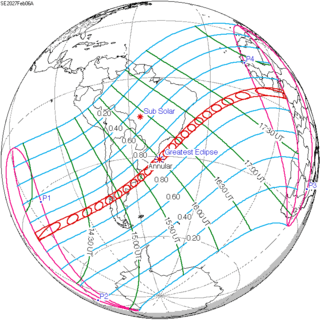 February 6, 2027 |
 November 25, 2030 |
 September 12, 2034 |
| 137 | 139 | 141 | 143 | 145 |
 July 2, 2038 |
 April 20, 2042 |
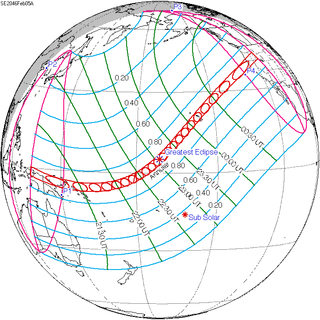 February 5, 2046 |
 November 25, 2049 |
 September 12, 2053 |
| 147 | 149 | 151 | 153 | 155 |
 July 1, 2057 |
 April 20, 2061 |
 February 5, 2065 |
 November 24, 2068 |
 September 12, 2072 |
| 157 | ||||
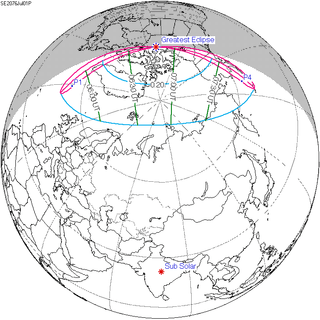 July 1, 2076 | ||||
References
| Wikimedia Commons has media related to Solar eclipse of 2023 April 20. |
External links
- Earth visibility chart and eclipse statistics Eclipse Predictions by Fred Espenak, NASA/GSFC
